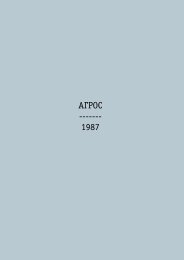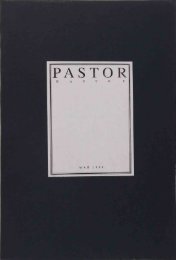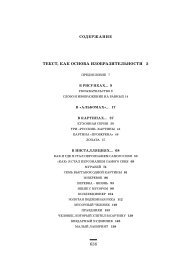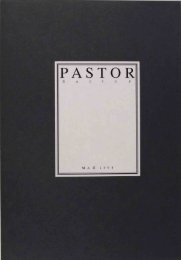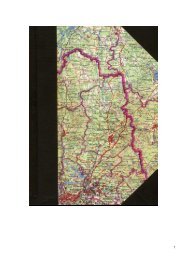Для простоты приводится схема идеального портрета с полным наборомгеральдических знаков, имеющихся на момент написания этого текста, и системаих динамического и порождающего взаимодействия, с возможной вариациейзначения в каждом отдельном случае как сотворения, так и восприятия. Пояснимпредполагающиеся служебные значения знаков:1. За спиной персонажа в белом как бы плавающем нецентрированном кольце– согласные буквы фамилии персонажа, как бы основа, почва, твердость иуверенность в возможности.2. В маленьком кольце, выходящем изо рта персонажа, - гласные буквы егофамилии – огласовка, как бы дыхание, анимация, полет, движение, жизнь.3. В кольце же справа снизу – начальная буква имени персонажа – возможностьдальнейшего развертывания в полное имя, в персону.4. Слева белое пятно, белое солнце, представитель (как бы Архангел) всего белогов рисунке, так как рисунок и есть борьба белого и черного.5. Слева же черное солнце в виде тонкой белой кольцевой обводки– представительвсего черного (не обязательно только и исключительно ужасного, в обычнойинтерпретации).6. Слеза в глазу – сердце.7. Черный зрачок с белой точкой – душа, свет, который и в тьме светит, иодновременно магическое видение.8. Серьга – благородство и одновременно спрятанная в раковину и перламутржемчуга тайна собственной жизни.9. Браслет – благородство и одновременно связанность с предназначением, миссией,служением, долгом.10. Глаз над головой персонажа – сверхчеловеческое видение, одновременноприсутствие высшего начала, отмеченного также красной точкой над глазом; краснаяслеза – знак сострадания и одновременно полноты , покоя в движении.11,12,13. Красные знаки на вертикальной оси организма – во лбу, в солнечномсплетении, в паху – основные чакры, точки прикосновения внешних сил космоса ивнутренних организма.14. Капля молока из груди – женская плодотворящая сила.15. Зеленой росток из другой груди – облагораживающая глори – фицирующая сила.16. Маленький блестящий шар на голове персонажа - знак силы сосредоточения ,ухода в себя, растворения в созерцании.17. Лозунг персонажа как аритикуляция его миссии, служения и, в результате,свершения.18. Яйцо – символ первичной космологической субстанции; пустое яйцо означает,что акт творения произошел и превалирует значение личного убежища, жилища,приватизации космоса.19. Кресты по бокам персонажа: так как по индоевропейским правилам ипостроениям вверх и вниз персонаж может двигаться только волею креатора (т.е.моей волей, в данном случае), но по горизонтали в космосе он может передвигатьсясобственной волей, эти кресты временно, на срок нашего медитативного общенияс ним, удерживают персонаж в пределах рисунка, а также, будучи крестообразнымпересечением координат, центрируют его в точке этого перекрещения и,соответственно, в мирового пространства.20, 21. Красные кружочки над крестами – свидетельство высшей легитимации.22. Белое пятно в черном пространстве яйца (или пятна) неиссякаемая энергиястановления в уже состоявшемся космосе.23,24. Черный и белый квадраты – символ структурной и интеллигибельной силыкосмоса материального и духовного.25. Капля спермы – мужская оплодотворяющая сила и в ряду трех текучестей –слеза, капля молока – основополагающая презентация динамичной текучести,изменчивости.26,27. Два белых прорыва с текстами в области большого кольца с согласнымибуквами фамилии персонажа обнаруживают весь рисунок как условную системуопределенной визуальной изобразительности, языка, и показывают легкуювозможность ухода, прорыва в иное пространство с вербальными отрывками совсеминого сюжета и семантического пласта.В конце следует обратить внимание зрителя и читателя, что персонажи являютсяандрогинами, символическое значение чего особо оговаривать нет необходимости,и что данные портреты являются изображением метафизических прототипов своихреальных воплощений, которые из полного набора значений могут, да и так оно иесть, реализовать в своих последующих инкарнациях лишь какую-то ограниченнуюих часть. Дмитрий Александрович ПриговСхема портрета с набором геральдических знаков и система их взаимодействия /Scheme of a Portrait With a Set of Heraldic Signs and System of Their Coordination, 1992
For the sake of simplicity a diagram is here presented of an ideal portrait with a full selection of the heraldic symbols available as of this writing, and the system of their dynamic and generative interaction, with possible variationsin meaning in each individual instance both of creation and of perception. We will expound on the intended subordinate meaning of the symbols:1. Behind the back of a personage in a white, seemingly floating uncentered ring – the consonants of the surname of the personage, like foundation, ground, firmness, and confidence in ability.2. In a small ring coming from the mouth of a personage, the vowels of his surname – like vocalization, breath, animation, flight, movement, life.3. In a ring to the lower right, the first letter of a personage's name – possibility for further expansion into a full name, a person.4. To the left, a white spot, a white sun, the representative (like an Archangel) of everything white in the picture, since the picture is itself a struggle between white and black.5. Also to the left, a black sun in the form of a thin white circular loop – the representative of everything black (not necessarily solely and exclusively horrible, in the usual interpretation).6. A tear in the eye – the heart.7. Black pupil with a white spot – soul, light that shines in darkness, and simultaneously magical vision.8. Earring – nobility and simultaneously, hidden in shell and mother-of-pearl, the mystery of one's own life.9. Bracelet – nobility and simultaneously connectedness with destiny, mission, service, duty.10. Eye above the head of a personage – superhuman vision, simultaneously presence of divine principle, also denoted by a red dot above the eye; a red tear – symbol of compassion and simultaneously of completeness, rest inmotion.11, 12, 13. Red symbols on the vertical axis of the body – on the forehead, the solar plexus, and the groin – the primary chakra, the points of contact for the external powers of the cosmos and the internal powers of the body.14. Drops of milk from the breast – feminine fertile power.15. Green shoot from the other breast – ennobling glorifying power.16. Small shiny orb on the head of a personage – symbol of power of concentration, withdrawal into oneself, dissolution in contemplation.17. Motto of the personage as the articulation of their mission, service, and the resulting completion.18. Egg – symbol of primal cosmological substance; an empty egg signifies that the act of creation took place, and the meaning of personal refuge, habitation, and privatization of the cosmos predominates.19. Crosses on the sides of the personage: since according to Indo-European rules and constructs the personage may move up and down only by the will of the creator (i.e., my will, in this case), but can move horizontally inthe cosmos by his own will, these crosses temporarily, for the period of our meditative communion with him, retain the personage within the bounds of the picture, and also, being a crosswise intersection of the coordinates,centralize him at the point of this intersection and, consequently, in universal space.20, 21. Red circlets above crosses – testimony of supreme legitimation.22. White spot in the black space of an egg (or spot) – the inexhaustible energy of formation in the already existing cosmos.23, 24. Black and white squares – symbol of the structural and intelligible power of the material and spiritual cosmos.25. Drops of sperm – masculine fertile power and one of the three liquidities – the tear and the milk drop – fundamental presentation of dynamic liquidity, changeability.26, 27. Two white break-offs with the texts in the sphere of a large ring with vowels of the surname of the personage bear the entire picture as a relative system of definite visual imagery and language, and show the easy possibilityof departure, breaking off into another space with verbal breaks of an entirely different theme and semantic course.At the end, the attention of the viewer and the reader should be called to the fact that the personages are androgynes, the symbolic significance of which need not be particularly described, and that these portraits are a depictionof metaphysical prototypes of their actual incarnations, which from a complete selection of meanings may, and indeed do, realize in their subsequent incarnations but a certain limited part thereof.Dmitry Aleksandrovich Prigov
- Page 2 and 3:
ЕЖЕГОДНЫЙ МЕЖДУНАР
- Page 5:
Объекты радикально
- Page 9 and 10:
Большого театра. Ка
- Page 11 and 12:
мы, её динамики, её
- Page 13 and 14:
является архивом, а
- Page 15 and 16:
Автопортрет с завя
- Page 17 and 18:
Кабачок/ Kabachok (Marrow Sq
- Page 19 and 20:
Портрет В. Захарова
- Page 21 and 22:
Потерянный день/ Lost
- Page 23 and 24:
Краткая история со
- Page 25 and 26:
Краткая история со
- Page 27 and 28:
1. Трещины на стене.2
- Page 29 and 30:
1. Магнитофон «Grundig»
- Page 31 and 32:
1. Саксофон, выданны
- Page 33 and 34:
1. Сломанный электр
- Page 35 and 36:
1. Бонги, принесенны
- Page 37 and 38:
1. «Наш флаг», изгот
- Page 39 and 40:
Портрет Монастырск
- Page 41 and 42:
В 1986 г. Герман Виног
- Page 43 and 44:
Художники! Прошу не
- Page 45 and 46:
Рисунок к изданию П
- Page 47 and 48:
Сирень/ Lilac, 1987СЕРГЕ
- Page 49 and 50:
Без названия/ Untitled,
- Page 51 and 52:
Шпиц/ Spitz, 1988
- Page 53 and 54:
АНАТОЛИЙ ЖУРАВЛЕВAN
- Page 55 and 56:
Я никогда ничего не
- Page 57 and 58:
Пролетарии, на пара
- Page 59 and 60:
Рисунок к изданию П
- Page 61 and 62:
Филенидка/ Filenidka, 1985
- Page 63 and 64:
Лукъянчик/ Lukjanchik, 198
- Page 65 and 66:
Труп отца!/ Father's Corpse
- Page 67 and 68:
Мне с нею познакоми
- Page 69 and 70:
Моя бабушка .../My Grandm
- Page 71 and 72:
ЕЛЕНА ЕЛАГИНАELENA ELAG
- Page 73 and 74:
Вредители/ Pests, 1999
- Page 75 and 76:
Спальный мешок из с
- Page 77 and 78:
Кережка и волокуша
- Page 79 and 80:
Исход/ Exodus, 1976, 1983ИГ
- Page 86 and 87:
Серию Выбор цели я
- Page 89 and 90:
Лозунг КД (Коллекти
- Page 91 and 92:
Made in Slum/ Made in Slum, 2007
- Page 93 and 94:
АНДРЕЙ МОНАСТЫРСКИ
- Page 95 and 96:
Посвящение Вадиму
- Page 97 and 98:
Смерть мухам / Death to
- Page 99 and 100:
Глубокая задумчиво
- Page 101 and 102:
ВЛАДИМИР НЕМУХИНVLAD
- Page 103 and 104:
Валет. Из серии рис
- Page 105 and 106:
ПАВЕЛ ПЕППЕРШТЕЙНPA
- Page 107 and 108:
Динарий Кесаря/ Cesar
- Page 109 and 110:
Поединок Номы и Сов
- Page 111 and 112:
ВИКТОР ПИВОВАРОВVIKT
- Page 113 and 114:
Донесение о состоя
- Page 115 and 116:
ДМИТРИЙ ПРИГОВDMITRI P
- Page 117 and 118: Рисунок к изданию П
- Page 119 and 120: Без названия/ Untitled,
- Page 121 and 122: Артек/ Artek, 1989
- Page 123 and 124: АНДРЕЙ РОЙТЕРANDREI ROI
- Page 125 and 126: ВИКТОР СКЕРСИСVIKTOR S
- Page 127 and 128: Модель искусства /Th
- Page 129 and 130: Музыкальные инстру
- Page 131 and 132: Машина Юстиции / Machi
- Page 133 and 134: Лес / The Forest, 1985
- Page 135 and 136: АНДРЕЙ ФИЛИППОВANDREI
- Page 137 and 138: Приглашение на ужи
- Page 139 and 140: ЧЕМПИОНЫ МИРАГиа А
- Page 141 and 142: Таймс / The Times, 1986
- Page 143 and 144: Эта работа первона
- Page 145 and 146: Рисунок к изданию П
- Page 147 and 148: Без названия (Лодки
- Page 149 and 150: Серия рисунков, соб
- Page 151 and 152: До р о т е я Цв и р н
- Page 153 and 154: актуальные проблем
- Page 155 and 156: время важных мероп
- Page 157 and 158: Пастор Nr.1 - Имена / Pa
- Page 159 and 160: Никита Алексеев, Юр
- Page 161 and 162: Иллюстрации к Детс
- Page 163 and 164: В ос но ву из да ния
- Page 165 and 166: Достаточно легкого
- Page 167: Вла д и м и р На у м е




